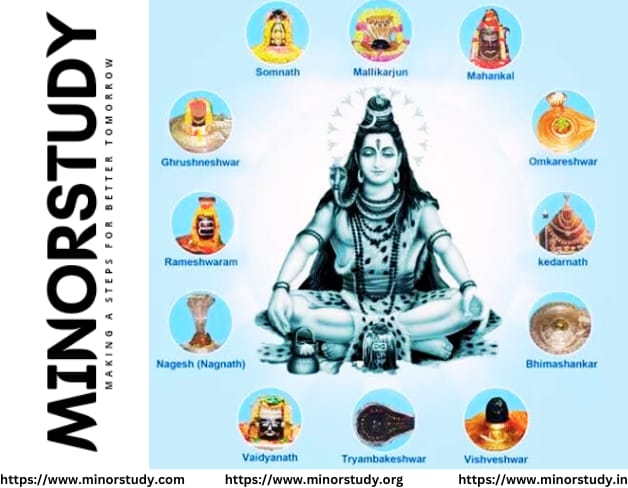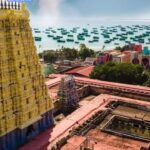🕉️ Introduction: The Divine Flame of Jyotirlingas
Jyotirlingas: In the heart of Sanatan Dharma lies the sacred symbolism of the Jyotirlingas – spiritual pillars of infinite light representing Lord Shiva. These aren’t just temples but vibrant energy centers said to radiate the divine cosmic power of Shiva Tattva. Across the Indian subcontinent, 12 Jyotirlingas stand as testimony to devotion, mysticism, and age-old tradition. These shrines are revered as the most sacred abodes of Lord Shiva and are collectively called the “Dwadash Jyotirlingas“.
- 🕉️ Introduction: The Divine Flame of Jyotirlingas
- 📜 History and Mythology Behind the Jyotirlingas
- 📍List of the 12 Jyotirlingas (with States)
- 🗓️ Timeline of Jyotirlingas
- 🔍 Detailed Significance of Each Jyotirlinga
- 1. Somnath (Gujarat)
- 2. Mallikarjuna (Andhra Pradesh)
- 3. Mahakaleshwar (Ujjain)
- 4. Omkareshwar (Madhya Pradesh)
- 5. Kedarnath (Uttarakhand)
- 6. Bhimashankar (Maharashtra)
- 7. Kashi Vishwanath (Uttar Pradesh)
- 8. Trimbakeshwar (Maharashtra)
- 9. Vaidyanath (Jharkhand)
- 10. Nageshwar (Gujarat)
- 11. Rameshwaram (Tamil Nadu)
- 12. Grishneshwar (Maharashtra)
- 🙏 Observance & Worship Rituals
- 📌 Key Facts About Jyotirlingas
- ❓ Frequently Asked Questions (FAQs)
- ✨ Wishing Message for Devotees
- 🌿 Importance in Daily Life & Society
- 🧠 Conclusion: Why Jyotirlingas Matter in Today’s World
Let us now journey into the mystical 12 Jyotirlingas, uncovering their history, timeline, legends, spiritual significance, and how they deeply impact our daily lives and societal ethos.
📜 History and Mythology Behind the Jyotirlingas
The concept of Jyotirlingas originates from Shiva Purana, where Lord Shiva appeared as a fiery pillar of light (Jyoti) to settle a cosmic dispute between Brahma and Vishnu. These pillars are believed to manifest where the divine light of Shiva touched the Earth.
The term “Jyotirlinga” means “pillar of light”, symbolizing the formless and limitless nature of Shiva. There are countless Jyotirlingas, but 12 are especially revered, each holding a unique legend and energy.
📍List of the 12 Jyotirlingas (with States)
Somnath – Prabhas Patan, Gujarat
Mallikarjuna – Srisailam, Andhra Pradesh
Mahakaleshwar – Ujjain, Madhya Pradesh
Omkareshwar – Mandhata Island, Madhya Pradesh
Kedarnath – Uttarakhand
Bhimashankar – Pune, Maharashtra
Kashi Vishwanath – Varanasi, Uttar Pradesh
Trimbakeshwar – Nashik, Maharashtra
Vaidyanath (Vaijnath) – Deoghar, Jharkhand
Nageshwar – Dwarka, Gujarat
Rameshwaram – Tamil Nadu
Grishneshwar – Aurangabad, Maharashtra
🗓️ Timeline of Jyotirlingas
| Jyotirlinga | Period of Origin | Associated Text |
|---|---|---|
| Somnath | Treta Yuga | Skanda Purana |
| Mallikarjuna | Dwapara Yuga | Shiva Purana |
| Mahakaleshwar | Satya Yuga | Koti Rudra Samhita |
| Kedarnath | Treta Yuga | Mahabharata |
| Rameshwaram | Treta Yuga | Ramayana |
| Kashi Vishwanath | Eternal (Swayambhu) | Vedas |
| Others | Varying ages across Yugas | Shiva Purana |
🔍 Detailed Significance of Each Jyotirlinga
1. Somnath (Gujarat)
Significance: Known as the first Jyotirlinga, it symbolizes the victory of faith over destruction, having been rebuilt many times.
2. Mallikarjuna (Andhra Pradesh)
Significance: Associated with Lord Shiva and Devi Parvati, it symbolizes marital harmony and family bonding.
3. Mahakaleshwar (Ujjain)
Significance: The only Dakshinamukhi (south-facing) Jyotirlinga. Believed to protect against untimely death.
4. Omkareshwar (Madhya Pradesh)
Significance: Resides on an island shaped like ‘ॐ’ – a representation of cosmic sound and divine energy.
5. Kedarnath (Uttarakhand)
Significance: The highest Jyotirlinga in the Himalayas, worshipped for liberation (moksha) and penance.
6. Bhimashankar (Maharashtra)
Significance: Known to destroy evil, it’s linked to the legend of demon Tripurasura’s defeat.
7. Kashi Vishwanath (Uttar Pradesh)
Significance: Symbol of spiritual illumination, it is said Shiva whispers the Taraka mantra at the time of death.
8. Trimbakeshwar (Maharashtra)
Significance: Source of the sacred Godavari River. Uniquely, the Lingam contains three faces (Brahma, Vishnu, Mahesh).
9. Vaidyanath (Jharkhand)
Significance: Worshipped as the divine healer. Believed to cure ailments and fulfill wishes.
10. Nageshwar (Gujarat)
Significance: Protector of devotees from poison and negative forces.
11. Rameshwaram (Tamil Nadu)
Significance: Associated with Lord Rama. Emphasizes devotion, dharma, and redemption.
12. Grishneshwar (Maharashtra)
Significance: The smallest Jyotirlinga but immense in spiritual magnitude. Known for family blessings and fertility.
🙏 Observance & Worship Rituals
Each Jyotirlinga is a pilgrimage center visited by lakhs of devotees annually. Common rituals include:
Abhishekam with water, milk, honey, ghee
Chanting of “Om Namah Shivaya” and Rudram
Maha Shivaratri and Shravan month are peak times
Pilgrims undertake parikrama and observe vrats (fasts)
📌 Key Facts About Jyotirlingas
All Jyotirlingas are self-manifested (Swayambhu).
Mentioned extensively in Shiva Purana, Skanda Purana, and Padma Purana.
Most Jyotirlingas are situated near sacred rivers or mountain regions.
Pilgrimage to all 12 is considered a path to Moksha (liberation).
Many Jyotirlingas were reconstructed after invasions – a symbol of cultural resilience.
❓ Frequently Asked Questions (FAQs)
Q1: Can we visit all 12 Jyotirlingas in one life?
Absolutely. Many devotees undertake this sacred journey over years. Special tour packages also exist.
Q2: Which is the most powerful Jyotirlinga?
All are equal spiritually, but Kashi Vishwanath, Somnath, and Mahakaleshwar hold historical and cultural prominence.
Q3: What language are original Jyotirlinga references in?
Primarily Sanskrit, found in ancient Puranas.
Q4: Are women allowed in all Jyotirlingas?
Yes, except during specific rituals at a few temples, access is generally open to all.
Q5: Is online darshan available?
Yes. Most temples offer live aarti and online donation portals.
✨ Wishing Message for Devotees
“May the divine Jyotirlingas light up your life with the spiritual brilliance of Lord Shiva. May your path be blessed with wisdom, health, and liberation. Har Har Mahadev!”
🌿 Importance in Daily Life & Society
Jyotirlingas promote unity in diversity across Indian states.
Encourage spiritual tourism, empowering local economies.
Their stories teach moral values like humility, truth, and inner light.
Inspire devotional art, architecture, music, and literature.
Visiting them instills mental peace, self-discipline, and emotional healing.
🧠 Conclusion: Why Jyotirlingas Matter in Today’s World
In an age of chaos, Jyotirlingas stand as timeless beacons of divine order, energy, and hope. They bridge the physical and metaphysical – reminding us that within every soul lies a Jyoti (light). Whether you’re religious or spiritual, the 12 Jyotirlingas offer deep lessons in endurance, devotion, and cosmic balance.
These shrines are not just geographical destinations but inner journeys – sacred mirrors reflecting our own Shiva nature.









nice
good
good